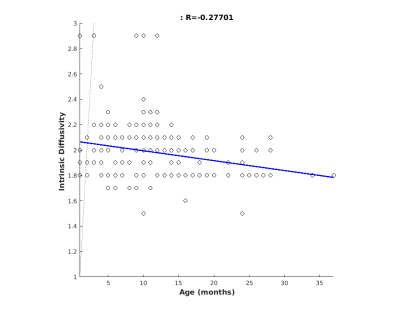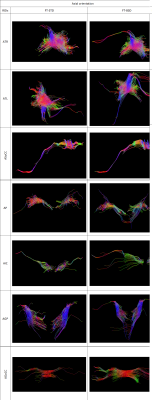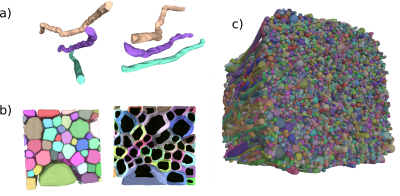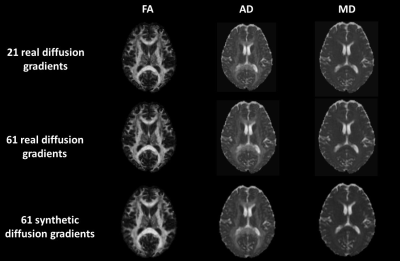Digital Poster
White Matter Microstructure in Health
Joint Annual Meeting ISMRM-ESMRMB & ISMRT 31st Annual Meeting • 07-12 May 2022 • London, UK

| Computer # | ||||
|---|---|---|---|---|
2817 |
97 | Assessing intrinsic parallel diffusivity changes in pediatric subjects acquired with NODDI. Video Not Available
Antonio Napolitano1, Martina Lucignani1, Chiara Parrillo1, Maria Camilla Rossi Espagnet1, Daniela Longo1, and Lorenzo Figà Talamanca1
1Bambino Gesù Children's Hospital, Rome, Italy
Investigating optimal NODDI intrinsic diffusivity d|| values in the first years of life would provide accurate diffusion properties estimation. We aimed to investigate d|| for 1-36 months range. Diffusion data from 265 baby Human Connectome Project subjects were processed and used for NODDI model fitting with MDT tool. Among different d|| tested, optimal value was chosen according to maximum LogLikelihood maps and investigated as a function of age. Infants exhibit optimal d|| values of 1.95 µm2 ms-1, where d|| decreases for increasing age. Based on our results, 1.7 µm2 ms-1 represent a suboptimal assumption in the case of infant population.
|
||
2818 |
98 | The effect of systematic errors reduction in the brain DTI on the 1.5T clinical MR scanner.
Anna Stefańska-Bernatowicz1, Weronika Mazur2, Rafał Obuchowicz3, and Artur Tadeusz Krzyżak1
1Faculty of Geology, Geophysics and Environmental Protection, AGH University of Science and Technology, Kraków, Poland, 2Faculty of Physics and Applied Computer Sciences, AGH University of Science and Technology, Kraków, Poland, 3Department of Diagnostic Imaging, Jagiellonian University Medical College, Kraków, Poland
BSD DTI is a method to reduce systematic errors observed in standard Diffusion Tensor Imaging (DTI) of anisotropic tissues. In the work the effect of systematic errors reduction was shown based on DTI of the brain. Diffusion tensor parameters and tractography were compared between standard DTI (STD) and after the application of BSD DTI method in 11 ROIs chosen in axial and sagittal image planes. Depending on ROI eigenvalues and FA were under- or overestimated in STD, which was corrected by BSD DTI. Reduction of systematic errors leads to decreased standard deviation and improved diffusion tensor tractography.
|
||
2819 |
99 | Towards a high-density packing white matter substrate generator for Monte-Carlo simulations
Juan Luis Villarreal Haro1, Remy Gardier1, Erick J Canales-Rodríguez1, Gabriel Girard1,2,3, Jean-Philippe Thiran1,2,3, and Jonathan Rafael-Patino1,3
1Signal Processing Laboratory (LTS5), Ecole Polytechnique Fédérale de Lausanne (EPFL), Lausanne, Switzerland, 2CIBM, Center for Biomedical Imaging, Lausanne, Switzerland, 3Radiology Department, Centre Hospitalier Universitaire Vaudois and University of Lausanne, Lausanne, Switzerland
One main goal of Diffusion-Weighted Magnetic Resonance Imaging is to infer microscopic tissue properties from the measured signal. The use of Monte-Carlo Simulations for DW-MRI on realistic substrates will help the study of DWI-MRI signals in controlled environments and to investigate, extract, and validate approaches for the understanding of white matter features. In this work, we present a novel framework for creating complex white matter phantoms with unprecedented characteristics like high packing density greater than 90% intra-axonal volume fraction and voxel size of (140 um)3.
|
||
2820 |
100 | Augmentation of Diffusion-Encoding Gradient Directions with Deep Learning is not suitable for dMRI clinical studies
Justino Rafael Rodríguez-Galván1, Carmen Martín-Martín1, Antonio Tristán-Vega1, Carlos Alberola-López1, and Santiago Aja-Fernández1
1Laboratorio de Procesado de Imagen, Universidad de Valladolid, Valladolid, Spain
Validation in Deep Learning for enhancement of diffusion Magnetic Resonance Imaging results usually sticks to conventional image similarity metrics. Despite those results, further research on synthetic data may result in discordance with the real one. In this paper we have compared 61 real gradient directions against 61 quasi-identical synthetic gradient directions, obtained by subsampling the real ones, for the assessment of the differences between chronic and episodic migraine patients. Even with high image comparison metrics, differences in t-test are not compelling. For that reason, we do not recommend synthetic images for clinical use.
|
||
The International Society for Magnetic Resonance in Medicine is accredited by the Accreditation Council for Continuing Medical Education to provide continuing medical education for physicians.